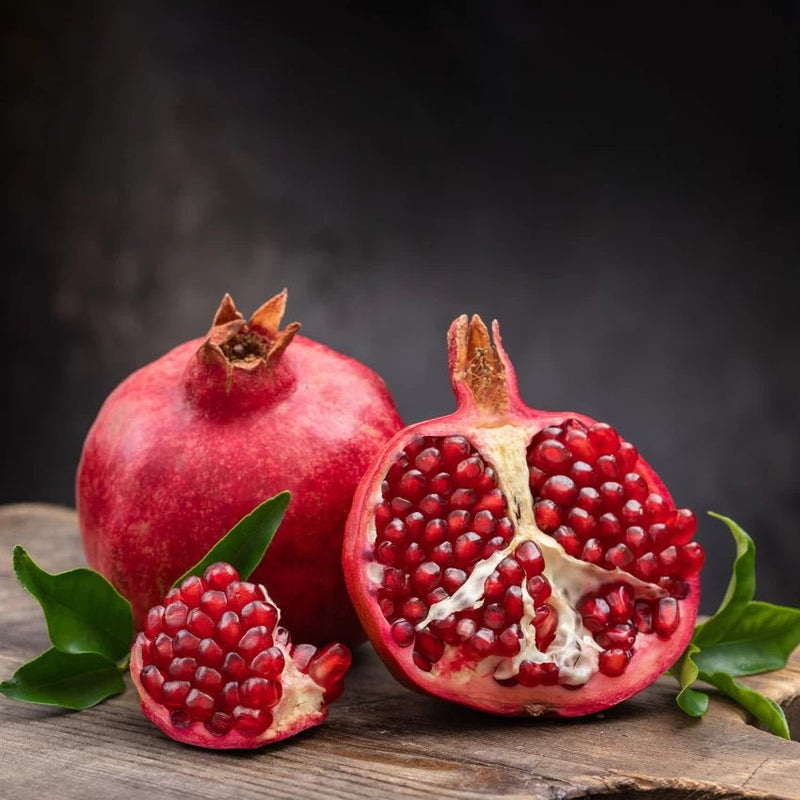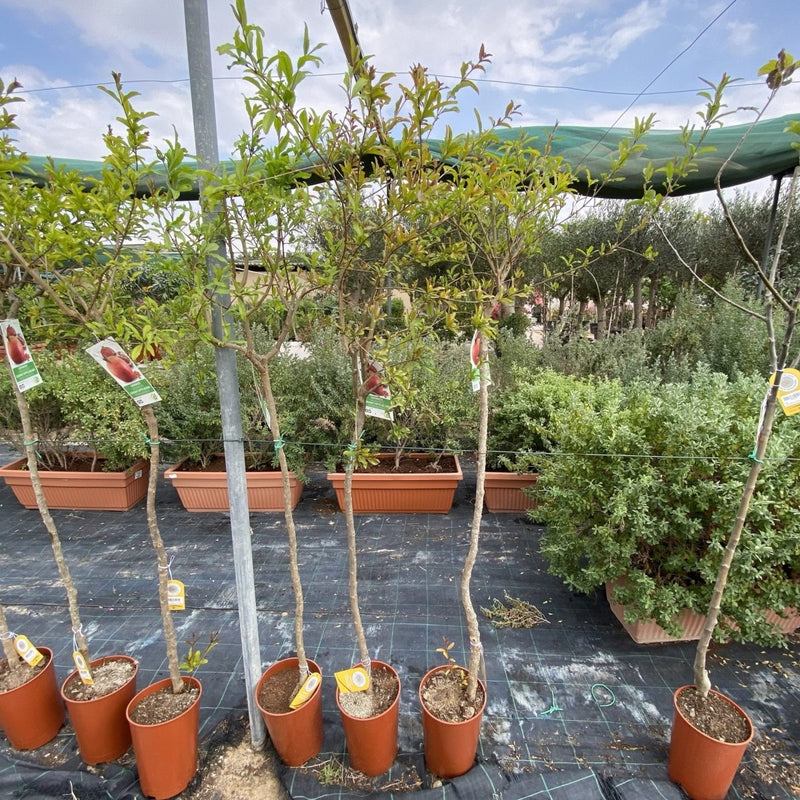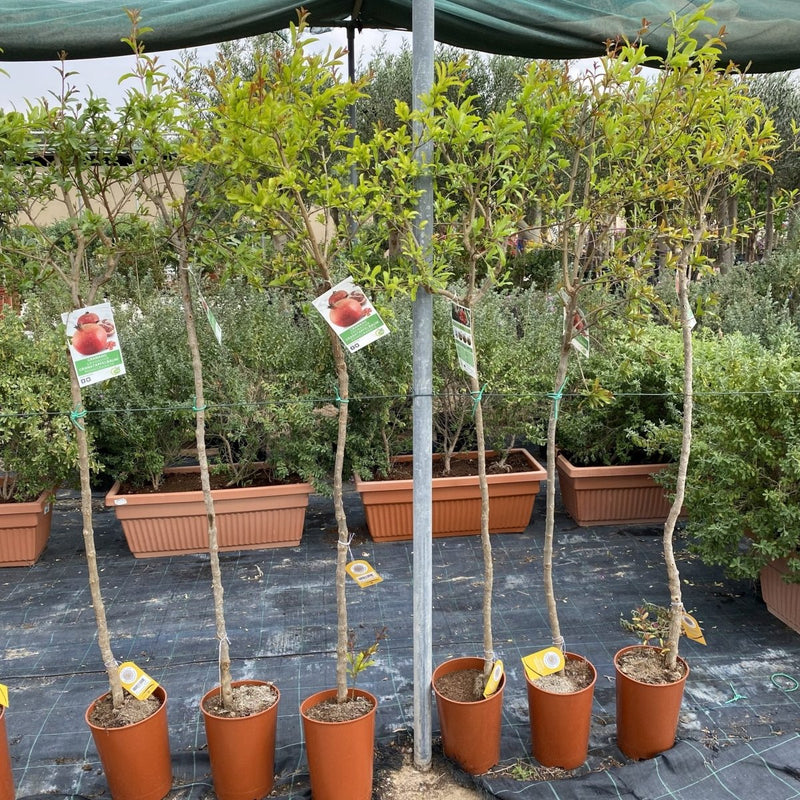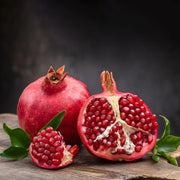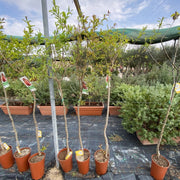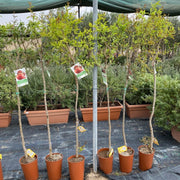Pomegranate Spanish 1.2-1.5m شجرة الرمان
Free returns on all eligible orders
You have 7 days to request a return. All sale items are final sale.
"Pomegranate Spanish 1.2–1.5m" refers to a young pomegranate tree cultivar, likely of Spanish origin, that stands between 1.2 to 1.5 meters tall. It's ideal for gardens or small orchards and known for its adaptability and fruit quality.
Here’s a detailed breakdown of what this means and what to expect from such a tree:
🌳 General Characteristics of the Pomegranate Tree (شجرة الرمان)
-
Scientific name: Punica granatum
-
Family: Lythraceae
-
Origin: Native to regions between Iran and the Himalayas; widely cultivated in the Mediterranean, including Spain.
-
Growth habit: Can be a shrub or small tree. In pots or young stages, it typically reaches 1–1.5 meters, which matches your reference.
-
Leaves: Oblong, glossy green, deciduous in cooler climates and evergreen in subtropical zones.
-
Bark: Twisted stems with spiny, gray bark.
🍎 Fruit and Cultivar Traits
-
Fruit type: Round with a thick rind, filled with juicy seeds (arils) that range from sweet to tart.
-
Spanish cultivars are often bred for:
-
High fruit quality
-
Vibrant red arils
-
Good resistance to drought and heat
-
-
Harvest season: Typically late summer to early autumn.
🌞 Growing Conditions
-
Sunlight: Requires full sun for optimal fruiting.
-
Soil: Tolerates poor soils but thrives in well-drained, loamy soil.
-
Watering: Drought-tolerant but benefits from controlled irrigation during flowering and fruiting.
-
Pruning: Regular pruning helps aerate the canopy and improve fruit yield.
🌿 Uses and Benefits
-
Nutritional: Rich in antioxidants, vitamins C and K.
-
Medicinal: Traditionally used for digestive health and anti-inflammatory properties.
-
Ornamental: Attractive flowers and fruit make it popular in landscape design.
-
Cultural significance: Widely referenced in Islamic, Christian, and Jewish traditions.
Pomegranate Spanish (Punica granatum) is a fruiting shrub or small tree highly prized in Spain for its historical, cultural, and agricultural significance.
Known as "granada" in Spanish, it thrives in the Mediterranean climate of the region and is particularly associated with the southern province of Granada, from which the fruit takes its name.
Tree:
Size: A deciduous shrub or small tree reaching 10–20 feet (3–6 meters) in height.
Trunk: Thin and slightly twisted, often with multiple stems or a single trunk when pruned.
Bark: Light brown to gray, smooth when young and fissured with age.
Leaves:
Type: Simple, glossy, and lance-shaped.
Color: Bright green in spring and summer, turning yellow in autumn before falling.
Flowers:
Type: Showy, bell-shaped flowers with crinkled petals.
Color: Bright orange-red.
Bloom Time: Late spring to early summer.
Pollination: Primarily self-pollinating but benefits from bees for increased fruit set.
Fruit:
Shape: Rounded, 2–5 inches (5–12 cm) in diameter.
Skin: Thick, leathery, and ranges in color from yellow-orange to deep red.
Seeds: Encased in juicy, jewel-like sacs called arils.
Taste: Sweet-tart with a refreshing flavor profile.
Ripening: Late summer to autumn (September to November in Spain).
Growing Conditions in Spain:
Climate:
Ideal Conditions: Thrives in the warm, dry summers and mild winters of Mediterranean climates.
Temperature Range: Tolerates heat but requires some winter chill (cold hardiness zones 7–11).
Soil:
Prefers well-drained soils, ranging from sandy to loamy.
Tolerates slightly alkaline soils, common in many parts of Spain.
Sunlight:
Requires full sun (6–8 hours daily) for optimal growth and fruit production.
Watering:
The Red Spanish Pomegranate Drought-tolerant once established but produces better fruit with consistent moisture.
Traditional irrigation systems, such as the ancient acequia canals, are still used in some regions.

